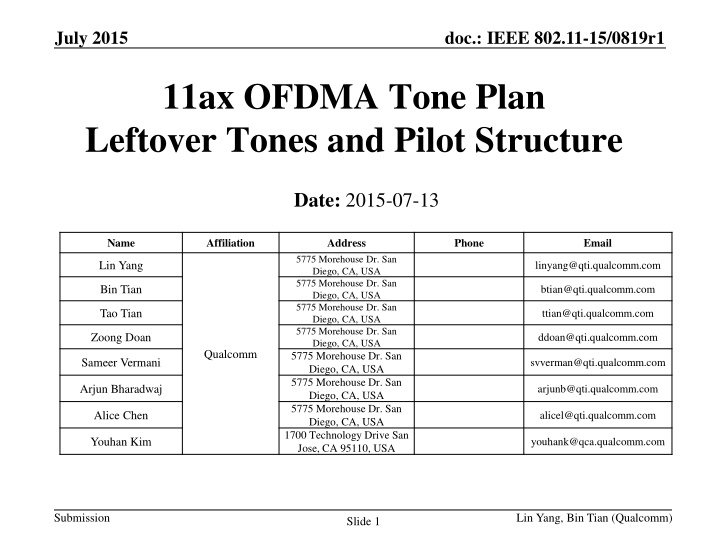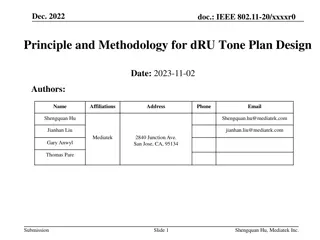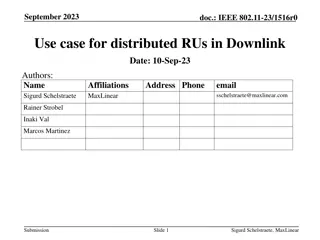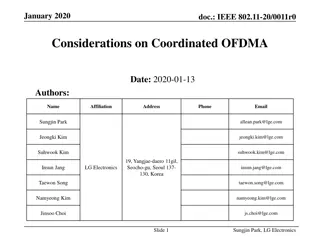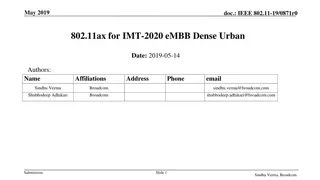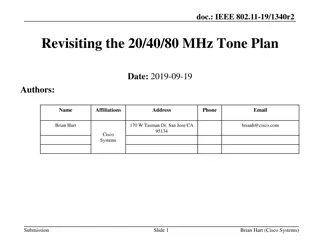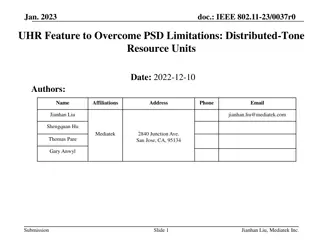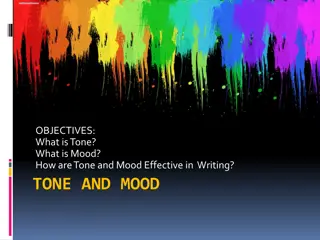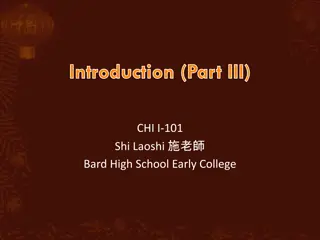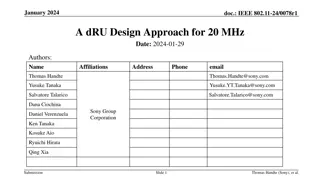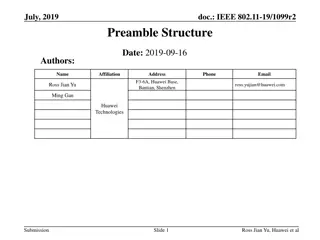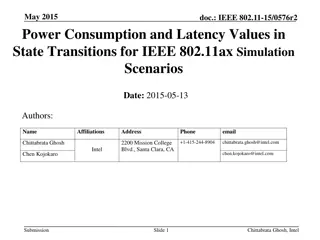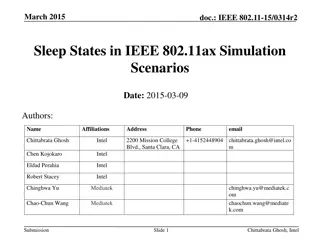IEEE 802.11-15/0819r1.11ax OFDMA Tone Plan Leftover Tones and Pilot Structure
This document discusses the IEEE 802.11-15/0819r1 standard focusing on OFDMA tone plan, leftover tones, and pilot structure, providing insights from multiple authors affiliated with leading technology companies. The content delves into technical details, addressing tone allocation, pilot signals, and connectivity strategies for enhanced wireless communication protocols. Authors from Qualcomm, Intel, Marvell, Broadcom, and Mediatek contribute to the comprehensive discussion on advancements in wireless technologies. The document sheds light on the evolving standards that shape the future of wireless networking and connectivity.
Download Presentation

Please find below an Image/Link to download the presentation.
The content on the website is provided AS IS for your information and personal use only. It may not be sold, licensed, or shared on other websites without obtaining consent from the author.If you encounter any issues during the download, it is possible that the publisher has removed the file from their server.
You are allowed to download the files provided on this website for personal or commercial use, subject to the condition that they are used lawfully. All files are the property of their respective owners.
The content on the website is provided AS IS for your information and personal use only. It may not be sold, licensed, or shared on other websites without obtaining consent from the author.
E N D
Presentation Transcript
July 2015 doc.: IEEE 802.11-15/0819r1 11ax OFDMA Tone Plan Leftover Tones and Pilot Structure Date: 2015-07-13 Name Affiliation Address Phone Email 5775 Morehouse Dr. San Diego, CA, USA 5775 Morehouse Dr. San Diego, CA, USA 5775 Morehouse Dr. San Diego, CA, USA 5775 Morehouse Dr. San Diego, CA, USA 5775 Morehouse Dr. San Diego, CA, USA 5775 Morehouse Dr. San Diego, CA, USA 5775 Morehouse Dr. San Diego, CA, USA 1700 Technology Drive San Jose, CA 95110, USA Lin Yang linyang@qti.qualcomm.com Bin Tian btian@qti.qualcomm.com Tao Tian ttian@qti.qualcomm.com Zoong Doan ddoan@qti.qualcomm.com Qualcomm Sameer Vermani svverman@qti.qualcomm.com Arjun Bharadwaj arjunb@qti.qualcomm.com Alice Chen alicel@qti.qualcomm.com Youhan Kim youhank@qca.qualcomm.com Submission Lin Yang, Bin Tian (Qualcomm) Slide 1
July 2015 doc.: IEEE 802.11-15/0819r1 Authors (continued) Name Affiliation Address Phone Email Straatweg 66-S Breukelen, 3621 BR Netherlands 5775 Morehouse Dr. San Diego, CA, USA 1700 Technology Drive San Jose, CA 95110, USA 5775 Morehouse Dr. San Diego, CA, USA 5775 Morehouse Dr. San Diego, CA, USA 5775 Morehouse Dr. San Diego, CA, USA Straatweg 66-S Breukelen, 3621 BR Netherlands Straatweg 66-S Breukelen, 3621 BR Netherlands 1700 Technology Drive San Jose, CA 95110, USA 5775 Morehouse Dr. San Diego, CA, USA 1700 Technology Drive San Jose, CA 95110, USA 1700 Technology Drive San Jose, CA 95110, USA Albert Van Zelst allert@qti.qualcomm.com Alfred Asterjadhi aasterja@qti.qualcomm.com Carlos Aldana caldana@qca.qualcomm.com George Cherian gcherian@qti.qualcomm.com Gwendolyn Barriac gbarriac@qti.qualcomm.com Hemanth Sampath hsampath@qti.qualcomm.com Qualcomm Menzo Wentink mwentink@qti.qualcomm.com Richard Van Nee rvannee@qti.qualcomm.com Rolf De Vegt rolfv@qca.qualcomm.com Simone Merlin smerlin@qti.qualcomm.com Tevfik Yucek tyucek@qca.qualcomm.com VK Jones vkjones@qca.qualcomm.com Submission Lin Yang, Bin Tian (Qualcomm) Slide 2
doc.: IEEE 802.11-15/0819r1 Authors (continued) Name Ron Porat Sriram Venkateswaran Matthew Fischer Leo Montreuil Andrew Blanksby Vinko Erceg Affiliation Address Phone Email rporat@broadcom.com mfischer@broadcom.com Broadcom Robert Stacey robert.stacey@intel.com Eldad Perahia eldad.perahia@intel.com Shahrnaz Azizi shahrnaz.azizi@intel.com 2111 NE 25th Ave, Hillsboro OR 97124, USA Po-Kai Huang po-kai.huang@intel.com +1-503-724-893 Qinghua Li Intel quinghua.li@intel.com Xiaogang Chen xiaogang.c.chen@intel.com Chitto Ghosh chittabrata.ghosh@intel.com Laurent cariou laurent.cariou@intel.com Rongzhen Yang rongzhen.yang@intel.com Submission Lin Yang, Bin Tian (Qualcomm) Slide 3
doc.: IEEE 802.11-15/0819r1 Authors (continued) Name Affiliation Address Phone Email Hongyuan Zhang hongyuan@marvell.com Yakun Sun yakunsun@marvell.com Lei Wang Leileiw@marvell.com Liwen Chu liwenchu@marvell.com Jinjing Jiang jinjing@marvell.com Yan Zhang yzhang@marvell.com 5488 Marvell Lane, Santa Clara, CA, 95054 Rui Cao Marvell 408-222-2500 ruicao@marvell.com Jie Huang jiehuang@marvell.com Sudhir Srinivasa sudhirs@marvell.com Saga Tamhane sagar@marvell.com Mao Yu my@marvel..com Edward Au edwardau@marvell.com Hui-Ling Lou hlou@marvell.com Submission Slide 4
doc.: IEEE 802.11-15/0819r1 Authors (continued) Name Affiliation Address Phone Email No. 1 Dusing 1st Road, Hsinchu, Taiwan James Yee +886-3-567-0766 james.yee@mediatek.com Alan Jauh alan.jauh@mediatek.com chinghwa.yu@mediatek.co m frank.hsu@mediatek.com Mediatek Chingwa Hu Frank Hsu 2860 Junction Ave, San Jose, CA 95134, USA Thomas Pare +1-408-526-1899 thomas.pare@mediatek.com chaochun.wang@mediatek.c om james.wang@mediatek.com ChaoChun Wang James Wang Mediatek USA Jianhan Liu Jianhan.Liu@mediatek.com Tianyu Wu tianyu.wu@mediatek.com russell.huang@mediatek.co m joonsuk@apple.com Russell Huang Joonsuk Kim mujtaba@apple.com Aon Mujtaba Guoqing Li Apple guoqing_li@apple.com Eric Wong ericwong@apple.com Chris Hartman chartman@apple.com Submission Lin Yang, Bin Tian (Qualcomm) Slide 5
doc.: IEEE 802.11-15/0819r1 Authors (continued) Name Affiliation Address Phone Email pbarber@broadbandmobilete ch.com peterloc@iwirelesstech.com Phillip Barber The Lone Star State, TX Peter Loc F1-17, Huawei Base, Bantian, Shenzhen 5B-N8, No.2222 Xinjinqiao Road, Pudong, Shanghai F1-17, Huawei Base, Bantian, Shenzhen 5B-N8, No.2222 Xinjinqiao Road, Pudong, Shanghai 5B-N8, No.2222 Xinjinqiao Road, Pudong, Shanghai 10180 Telesis Court, Suite 365, San Diego, CA 92121 NA 303 Terry Fox, Suite 400 Kanata, Ottawa, Canada F1-17, Huawei Base, Bantian, Shenzhen 10180 Telesis Court, Suite 365, San Diego, CA 92121 NA F1-17, Huawei Base, Bantian, SHenzhen 303 Terry Fox, Suite 400 Kanata, Ottawa, Canada 5B-N8, No.2222 Xinjinqiao Road, Pudong, Shanghai Le Liu liule@huawei.com +86-18601656691 Jun Luo jun.l@huawei.com Yi Luo Roy.luoyi@huawei.com +86-18665891036 Yingpei Lin linyingpei@huawei.com Jiyong Pang pangjiyong@huawei.com Huawei Zhigang Rong zhigang.rong@huawei.com Rob Sun Rob.Sun@huawei.com David X. Yang david.yangxun@huawei.com Yunsong Yang yangyunsong@huawei.com Zhou Lan Lanzhou1@huawei.com +86-18565826350 Junghoon Suh Junghoon.Suh@huawei.com Jiayin Zhang zhangjiayin@huawei.com +86-18601656691 Submission Lin Yang, Bin Tian (Qualcomm) Slide 6
doc.: IEEE 802.11-15/0819r1 Authors (continued) Name Affiliation Address Phone Email Wookbong Lee wookbong.lee@lge.com Kiseon Ryu kiseon.ryu@lge.com Jinyoung Chun jiny.chun@lge.com Jinsoo Choi js.choi@lge.com 19, Yangjae-daero 11gil, Seocho-gu, Seoul 137- 130, Korea Jeongki Kim jeongki.kim@lge.com LG Electronics Giwon Park giwon.park@lge.com Dongguk Lim dongguk.lim@lge.com Suhwook Kim suhwook.kim@lge.com Eunsung Park esung.park@lge.com HanGyu Cho hg.cho@lge.com Thomas Derham Orange thomas.derham@orange.com #9 Wuxingduan, Xifeng Rd., Xi'an, China Bo Sun sun.bo1@zte.com.cn Kaiying Lv Yonggang Fang Ke Yao Weimin Xing Brian Hart Pooya Monajemi lv.kaiying@zte.com.cn yfang@ztetx.com yao.ke5@zte.com.cn xing.weimin@zte.com.cn brianh@cisco.com pmonajem@cisco.com ZTE 170 W Tasman Dr, San Jose, CA 95134 Cisco Systems Submission Lin Yang, Bin Tian (Qualcomm) Slide 7
doc.: IEEE 802.11-15/0819r1 Authors (continued) Name Affiliation Address Innovation Park, Cambridge CB4 0DS (U.K.) Maetan 3-dong; Yongtong-Gu Suwon; South Korea 1301, E. Lookout Dr, Richardson TX 75070 Innovation Park, Cambridge CB4 0DS (U.K.) 1301, E. Lookout Dr, Richardson TX 75070 Maetan 3-dong; Yongtong-Gu Suwon; South Korea Phone Email Fei Tong f.tong@samsung.com +44 1223 434633 Hyunjeong Kang hyunjeong.kang@samsung.com +82-31-279-9028 Kaushik Josiam k.josiam@samsung.com (972) 761 7437 Samsung Mark Rison m.rison@samsung.com +44 1223 434600 Rakesh Taori rakesh.taori@samsung.com (972) 761 7470 Sanghyun Chang s29.chang@samsung.com +82-10-8864-1751 Yasushi Takatori takatori.yasushi@lab.ntt.co.jp Yasuhiko Inoue inoue.yasuhiko@lab.ntt.co.jp 1-1 Hikari-no-oka, Yokosuka, Kanagawa 239-0847 Japan Yusuke Asai NTT asai.yusuke@lab.ntt.co.jp Koichi Ishihara ishihara.koichi@lab.ntt.co.jp Akira Kishida kishida.akira@lab.ntt.co.jp 3-6, Hikarinooka, Yokosuka- shi, Kanagawa, 239-8536, Japan Akira Yamada yamadaakira@nttdocomo.com watanabe@docomoinnovations. com hpapadopoulos@docomoinnova tions.com Fujio Watanabe NTT DOCOMO 3240 Hillview Ave, Palo Alto, CA 94304 Haralabos Papadopoulos Submission Lin Yang, Bin Tian (Qualcomm) Slide 8
July 2015 doc.: IEEE 802.11-15/0819r1 Introduction 11ax OFDMA tone plan was decided in IEEE May 2015 meeting [1] except the location of leftover tones 8 leftover tones within each 242 tone block, except in 20MHz PPDU 4 spare tones are already used for DC protection in OFDMA 11ax Pilot design and structure [2] provides some thoughts on 11ax pilot tone placement [3] addresses the pilot design in the 11ax data section This presentation will cover Pilot design for HE-LTF Pilot structure in 11ax: the location of pilot tones Submission Slide 9 Lin Yang, Bin Tian (Qualcomm)
July 2015 doc.: IEEE 802.11-15/0819r1 Leftover Tones Possible usage of leftover tones Separator between different RUs, especially smaller size RUs, to reduce leakage from adjacent block Additional edge protection from pulse shaping filter, adjacent blocker, etc. No power transmitted on the leftover tones In the following slides, we propose the OFDMA tone structures that implement the possible usage of leftover tones in a balanced way Submission Slide 10 Lin Yang, Bin Tian (Qualcomm)
doc.: IEEE 802.11-15/0819r1 Proposed Location of Leftover Tones (in orange color) 7 1 3 6 Edge 26 26 26 26 26 26 26 26 5 Edge 13 1 1 1 1 DC 1 3 7 DC 52 52 52 52 5 Edge 13 6 Edge 1 1 1 1 1 3 1 3 7 5 Edge 6 Edge 102+4 pilots 102+4 pilots DC 5 Edge 6 Edge 242 + 3 DC HE20 with 7DC for OFDMA 5 DC 12 Edge 26 26 26 26 26 26 26 26 26 26 26 26 26 26 11 Edge 26 26 26 26 2 1 1 2 2 1 1 1 1 2 1 1 5 DC 52 52 52 52 52 52 52 52 26 26 11 Edge 1 2 1 1 2 1 1 2 1 12 Edge 1 2 1 5 DC 11 Edge 12 Edge 102+4 102+4 102+4 102+4 26 26 1 1 1 1 1 1 1 1 5 DC 11 Edge 242 242 12 Edge HE40 2 6 1 3 1 3 2 6 1 3 1 3 7 DC 11 Edge 12 Edge 12 Edge 26 26 26 26 26 26 26 26 1 26 26 26 26 26 26 26 26 26 26 26 26 26 26 26 26 26 1 26 26 26 26 26 26 26 26 26 1 2 1 1 2 1 2 2 1 1 2 1 1 2 1 2 2 2 2 1 7 DC 11 Edge 52 52 52 52 52 52 52 52 52 52 52 52 52 52 52 52 26 26 1 26 1 1 1 2 26 2 1 2 1 1 2 2 2 1 2 1 2 1 1 2 1 2 1 3 1 3 11 Edge 7 DC 12 Edge 102+4 102+4 102+4 102+4 102+4 102+4 102+4 102+4 26 26 26 1 26 1 1 1 1 1 1 2 1 1 1 1 2 1 1 3 1 3 11 Edge 7 DC 12 Edge 242 242 242 242 12 Edge 996 usable tones +5 DC 11 Edge HE80 Submission Slide 11 Lin Yang, Bin Tian (Qualcomm)
July 2015 doc.: IEEE 802.11-15/0819r1 Pilot Design for HE-LTF 11ac introduced single stream pilots (SSP) to correct residual phase drift (CFO) in VHT-LTF In 11ax, 2x and 4x HE-LTF were adopted Longer LTF makes 11ax more sensitive to phase drift than 11ac Phase tracking in channel estimation for UL MU MIMO has been discussed in [4] Per stream orthogonal LTF was adopted to track per user CFO No pilots in HE-LTF In this presentation we will tackle phase tracking for SU, DL and UL OFDMA and DL MU-MIMO cases. Only one clock error source (per RU for UL OFDMA) needs to be tracked Submission Slide 12 Lin Yang, Bin Tian (Qualcomm)
July 2015 doc.: IEEE 802.11-15/0819r1 CFO Accuracy Requirement for SU Transmission The following plot shows how sensitive SU MIMO to CFO in HE-LTF Open-loop 1 user DL MIMO 6x8: SNR Loss due to CFO w.r.t. CFO=0Hz (at PER=10%), Pmatrix 2x LTFs 3 MCS1 MCS3 MCS5 MCS7 MCS9 2.5 2 1.5 SNR Loss (dB) 1 0.5 0 -0.5 -1 0 100 200 300 400 500 600 700 800 900 1000 CFO (Hz) MCS MCS1 MCS3 MCS5 MCS7 MCS9 SNR for 10%PER (dB) 9 16 23.9 27.4 32.7 CFO (Hz) >1000 742 337 256 127 Submission Slide 13 Lin Yang, Bin Tian (Qualcomm)
July 2015 doc.: IEEE 802.11-15/0819r1 Improving CFO Tracking in 11ax Preamble Two possible ways to meet the required CFO sensitivity Phase tracking during HE-LTF (discussed in the following slides) Improve CFO estimation before HE-LTF No pilots is needed during HE-LTF At least 4 symbols (L-SIG, RL-SIG, 2 HE-SIG-A) can be used for data-aided phase tracking Performance issue Significantly worse than SSP (11ac) based approach. Challenging to meet the CFO requirements for large number of SS, even with added complexity from data-aided CFO estimation SNR after L-LTF Data-aided up to SIGA 20MHz 1% Residual CFO 1% Residual CFO with HE-LTF 1% residual CFO (with 8 SSP) 30 dB 1.6KHz 270Hz 41Hz 20 dB 2.7KHz 400Hz 125Hz 10dB 7.6KHz 1.1KHz 360Hz Our preference: phase tracking during HE-LTF Better performance, more tolerance for HW impairments like LO bouncing Submission Slide 14 Lin Yang, Bin Tian (Qualcomm)
July 2015 doc.: IEEE 802.11-15/0819r1 Phase Tracking in HE-LTF Options for phase tracking in LTF Without pilots: using orthogonal per stream LTF (as in [4]) like in UL MU MIMO Pros No pilots needed in LTF More accumulation gain from larger number of LTF tones comparing to the pilot tones in LTF Less channel interpolation loss Consistent design with UL MU MIMO Cons Assumption for this approach is the Nss adjacent subcarriers share the same channel Additional complexity from spreading/despreading LTF sequence with different streams With pilots: assuming SSP as 11ac Pros Existing feature in 11ac Easy tracking Cons May have channel interpolation loss Need to remember pilot location, especially for 2x LTF Submission Slide 15 Lin Yang, Bin Tian (Qualcomm)
July 2015 doc.: IEEE 802.11-15/0819r1 Phase Tracking Performance CCDF of Phase-error with SNR=10dB,CFO=3KHz,DNLOS,8x8,11ac CSD CCDF of Phase-error with SNR=20dB,CFO=1KHz,DNLOS,8x8,11ac CSD 0 0 10 10 INTL 8 orth LTFs 8 SSP 6 SSP INTL 8 orth LTFs 8 SSP 6 SSP -1 -1 10 10 CCDF CCDF -2 -2 10 10 -3 -3 10 10 0 100 200 300 400 500 600 700 800 900 0 100 200 300 Frequency Error in Hz 400 500 600 700 800 Frequency Error in Hz Observation (details in Appendix): SSP provides much better phase tracking performance than orthogonal LTF for MIMO transmission in frequency selective channel at medium to high SNR Performance of orthogonal LTF case is limited by channel frequency selectivity Performance is very close between 8 SSP and 6 SSP in 20 MHz Submission Slide 16 Lin Yang, Bin Tian (Qualcomm)
July 2015 doc.: IEEE 802.11-15/0819r1 Channel Interpolation Loss MSE of Channel Interpolation with DNLOS, Noise Free, CFO Free, No Pilot in LTF MSE of Channel Interpolation with DNLOS,Noise Free, CFO Free, 8 SSP -20 -20 -25 -25 -30 -30 -35 -35 -40 -40 MSE in dB MSE in dB -45 -45 -50 -50 -55 -55 -60 -60 -65 -65 -70 -70 0 50 100 150 200 250 0 50 100 150 200 250 Tone Index Tone Index Notes: 2x LTF. Assuming noise and CFO free to study the interpolation loss Edge tone and tones around pilots have higher interpolation/extrapolation loss for channel estimation Submission Slide 17 Lin Yang, Bin Tian (Qualcomm)
July 2015 doc.: IEEE 802.11-15/0819r1 Impact of Channel Interpolation Loss Notes: 2x LTF CFO is set to zero to decouple its effect Practical timing, phase tracking is on in data symbol, smoothing is on Observation: Interpolation loss at pilot position has no noticeable impact to PER performance Submission Slide 18 Lin Yang, Bin Tian (Qualcomm)
July 2015 doc.: IEEE 802.11-15/0819r1 Discussion on Phase Tracking Approaches SSP performs significantly better than orthogonal LTF in CFO estimation in frequency selective channel (e.g. DNLOS) E.g. 20MHz 6 or 8 SSP can meet the CFO requirements For SSP, channel interpolation loss around pilot tones does not have noticeable impact on PER performance due to limited pilot density and low interpolation loss level Our preference: single stream pilot (11ac alike) in HE-LTF Submission Slide 19 Lin Yang, Bin Tian (Qualcomm)
July 2015 doc.: IEEE 802.11-15/0819r1 11ax Pilots in HE-LTF For 4x LTF, we can use the same SSP tone plan as in data (always 4x) Same number of pilots and pilot tone location as in data Similar to 11ac processing For 2x LTF New pilot tone location needs to be defined 2x LTF only populates every other tone in 4x OFDM symbol In current 4x data symbol, not all pilot tones have even indices Prefer to move all the pilot tones to even index in 4x OFDM symbol Same number of pilot tones in 4x data and 2x HE-LTF symbol Pilot index in 2x HE-LTF = Pilot index in 4x data /2 Submission Slide 20 Lin Yang, Bin Tian (Qualcomm)
July 2015 doc.: IEEE 802.11-15/0819r1 Pilot Structure for 26 Tone RU Keep relative pilot position close to what is defined in 11ah 11ah symmetric pilot structure of [6P12P6]: pilot indices are one even and one odd. 0 6 19 25 In 11ax, regardless of leftover tone allocation plan, there are three variations of pilot tone position within 26 tone RU Pos1: 26 tone RU having left most tone starting from even index may need structure of [6P13P5] 0 6 20 25 Pos2: left most tone starting from odd index may need structure of [5P13P6] 1 6 20 26 Pos3: center 26 tone RU, pilot structure would be [6P6 6P6] DC -16 -10 -4 4 10 16 To ensure all pilots with even tone indices, relative pilot location within 26 tone RU has to be varied for different 26 tone RUs Submission Slide 21 Lin Yang, Bin Tian, Qualcomm, et. al
July 2015 doc.: IEEE 802.11-15/0819r1 Fixed Pilot Structure Independent of Resource Allocation 11ax has to define new pilot positions for all RUs Legacy pilot design have pilots at odd indices Relative pilot position within a RU is not fixed Need to reduce HW burden on memorizing many variations of pilot positions Phase tracking performance is not sensitive to specific pilot distribution As far as all pilot tones are reasonably separated for frequency diversity Proposal: Fixed absolute pilot position per PPDU BW, independent of resource allocation Keep relative pilot position close to legacy design, when possible Align pilots of different RU size: use pilot puncture when needed Submission Slide 22 Lin Yang, Bin Tian (Qualcomm)
July 2015 doc.: IEEE 802.11-15/0819r1 Pilot Structure for RU >26 tones 52 tone RU Existing legacy pilot structure: half even half odd indices After moving to even index, perfectly align with pilots in the corresponding two 26 tone RUs 0 5 19 32 46 51 11a 52-tone pilot structure 0 6 20 25 26 32 46 51 106 tone RU Prefer to use available pilots in corresponding two 52 tone RUs with pilot puncturing 106 tones have 4 pilots while 2 x 52 have 8 Puncturing is performed in a mirror symmetric way within 242 tones to make it more evenly spread within 996 tone RU in 80MHz. 0 6 20 32 46 51 11ax 52-tone pilot structure with aligning to pilots in 26-tone RU -116 -90 -48 -22 22 48 90 116 -102 -76 -62 -36 -10 10 36 62 76 102 pilot tone index 7 1 3 6 Edge 26 26 26 26 26 26 26 26 5 Edge 13 1 1 1 1 DC 1 3 7 DC 52 52 52 52 5 Edge 13 6 Edge 1 1 1 1 1 3 7 5 Edge 6 Edge 102+4 pilots 102+4 pilots 13 DC 242 tone RU Same number of pilots as two 106 RUs Align with pilots in corresponding two 106 tone RUs 5 Edge 6 Edge 242 + 3 DC HE20 pilot structure Submission 23 Lin Yang, Bin Tian (Qualcomm)
July 2015 doc.: IEEE 802.11-15/0819r1 Proposed Pilot Locations -116 -90 -48 -22 22 48 90 116 -102 -76 -62 -36 -10 10 36 62 76 102 pilot tone index 7 1 3 6 Edge 26 26 26 26 26 26 26 26 5 Edge 13 1 1 1 1 DC 1 3 7 DC 52 52 52 52 5 Edge 13 6 Edge 1 1 1 1 1 3 7 5 Edge 6 Edge 102+4 pilots 102+4 pilots 13 DC 5 Edge 6 Edge 242 + 3 DC HE20 pilots tone index -238 -212 -170 -144 -104 -78 -36 -10 -224 -198 -184 -158 -130 -116 -90 -64 -50 -24 10 36 78 104 144 170 212 238 24 50 64 90 116 130 158 184 198 224 5 DC 12 Edge 26 26 26 26 26 26 26 26 26 26 26 26 26 26 11 Edge 26 26 26 26 2 1 1 2 2 1 1 1 1 2 1 1 5 DC 52 52 52 52 52 52 52 52 26 26 11 Edge 1 2 1 1 2 1 1 2 1 1 2 1 12 Edge 5 DC 11 Edge 12 Edge 102+4 102+4 102+4 102+4 26 26 1 1 1 1 1 1 1 1 5 DC 11 Edge 242 242 12 Edge HE40 -468 -400 -334 -266 -226 -158 -92 -24 24 92 158 226 266 334 400 468 50 118 184 252 292 360 pilot tone index -494 -426 -360 -292 -252 -184 -118 -50 -480 -454 -440 -414 -386 -372 -346 -320 -306 -280 -238 -212 -198 -172 -144 -130 -104 -78 -64 -38 -10 426 494 10 38 64 78 104 130 144 172 198 212 238 280 306 320 346 372 386 414 440 454 480 2 6 1 3 1 3 2 6 1 3 1 3 7 DC 11 Edge 12 Edge 12 Edge 26 26 26 26 26 26 26 26 1 26 26 26 26 26 26 26 26 26 26 26 26 26 26 26 26 26 1 26 26 26 26 26 26 26 26 26 1 2 1 1 2 1 2 2 1 1 2 1 1 2 1 2 2 2 2 1 7 DC 11 Edge 52 52 52 52 52 52 52 52 52 52 52 52 52 52 52 52 26 26 1 26 1 1 1 2 26 2 1 2 1 1 2 2 2 1 2 1 2 1 1 2 1 2 1 3 1 3 11 Edge 7 DC 12 Edge 102+4 102+4 102+4 102+4 102+4 102+4 102+4 102+4 26 26 26 1 26 1 1 1 1 1 1 2 1 1 1 1 2 1 1 3 1 3 11 Edge 7 DC 12 Edge 242 242 242 242 12 Edge 996 usable tones +5 DC 11 Edge HE80 Submission Slide 24 Lin Yang, Bin Tian (Qualcomm)
July 2015 doc.: IEEE 802.11-15/0819r1 Summary A balanced leftover tone placement plan is proposed for OFDMA tone plan Different CFO tracking approaches in 11ax preamble are compared and the solution of using single stream pilots (like in 11ac) in HE-LTF is recommended Fixed pilot structure is proposed, with the following salient benefits All pilots are placed at even tones for any RUs, such that 2x LTF and 4x LTF/data can use same set of pilots Fixed pilot location independent of resource allocation, making OFDMA processing simpler Pilot locations are aligned in all RUs, more implementation friendly Slide 25 Submission Lin Yang, Bin Tian (Qualcomm)
July 2015 doc.: IEEE 802.11-15/0819r1 Straw Poll 1 Do you agree to add the following to the 11ax SFD: The left over tones location for 20/40/80 MHz tone plan are shown in the diagrams as in slide 11? Note: Leftover tones have zero energy Y/N/A Submission Slide 26 Lin Yang, Bin Tian (Qualcomm)
July 2015 doc.: IEEE 802.11-15/0819r1 Straw Poll 2 Do you agree to add the following to the 11ax SFD: Single stream pilot (like 11ac) in HE-LTF shall be used for SU, DL and UL OFDMA as well as in DL MU-MIMO transmissions Y/N/A Submission Slide 27 Lin Yang, Bin Tian (Qualcomm)
July 2015 doc.: IEEE 802.11-15/0819r1 Straw Poll 3 Do you agree to add the following to the 11ax SFD: All pilot tones in 4x data OFDMA symbol are at even indices If pilots present in 4x HE-LTF, their tone indices shall be the same as those pilots in 4x data symbol If pilots present in 2x HE-LTF, their tone indices shall be the same as the indices of those pilots in 4x data symbol divided by 2 Y/N/A Submission Slide 28 Lin Yang, Bin Tian (Qualcomm)
July 2015 doc.: IEEE 802.11-15/0819r1 Straw Poll 4 Do you agree to add the following to the 11ax SFD: The pilot location for 20/40/80MHz bandwidth are as shown in the diagrams in slide 24 Note: 80MHz pilot positions are enumerated below for reference RU-26 pilots: 10, 24, 38, 50, 64, 78, 92, 104, 118, 130, 144, 158, 172, 184, 198, 212, 226, 238, 252, 266, 280, 292, 306, 320, 334, 346, 360, 372, 386, 400, 414, 426, 440, 454, 468, 480, 494 RU-106/242/484 pilots: 24, 50, 92, 118, 158, 184, 226, 252, 266, 292, 334, 360, 400, 426, 468, 494 RU-996 pilots: 24, 92, 158, 226, 266, 334, 400, 468 The pilot locations for 160MHz or 80+80 use the same structure as 80MHz for each half of the BW Y/N/A Submission Slide 29 Lin Yang, Bin Tian (Qualcomm)
July 2015 doc.: IEEE 802.11-15/0819r1 Reference [1] IEEE 802.11-15/0330r4 OFDMA Numerology and Structure [2] IEEE 802.11-16/0577r1 Pilot Design for 11ax [3] IEEE 802.11-15/0812r0 Pilot Design for Data Section [4] IEEE 802.11-15/0602r2 HE-LTF Sequence for UL MU-MIMO Submission Slide 30 Lin Yang, Bin Tian (Qualcomm)
July 2015 doc.: IEEE 802.11-15/0819r1 APPENDIX Submission Slide 31 Lin Yang, Bin Tian (Qualcomm)
July 2015 doc.: IEEE 802.11-15/0819r1 Simulation Setup 20MHz 8x8 D NLOS, 1x1 UMi NLOS 11ac CSD: [0 -400 -200 -600 -350 -650 -100 -750]ns SNR and CFO 20dB SNR with 1KHz CFO 10dB SNR with 3KHz CFO 6 dB SNR with 6KHz CFO 2x LTF Testing phase estimation approaches in LTF stage [1]-like Nss orthogonal LTF sequences for Nss streams SSP based: Using Same Number of Pilots in 2x LTF as in 4x LTF 8 pilots in 256FFT SSP based: Using 2x Numerology in 2x LTF for Pilots 6 pilots in 128FFT Testing metrics CCDF of frequency estimation error MSE of channel interpolation error Submission 32 Lin Yang, Bin Tian (Qualcomm)
